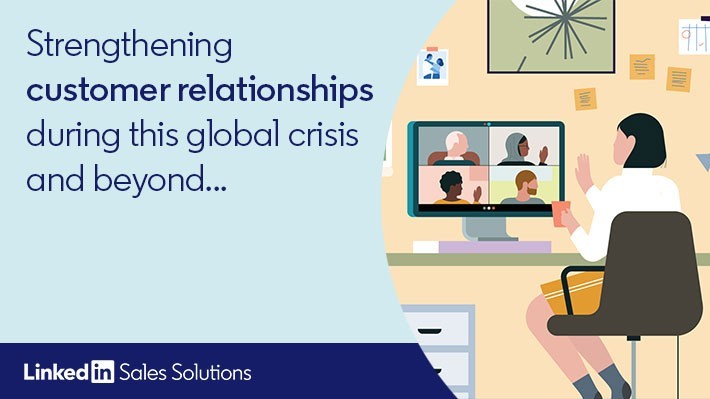Strengthening customer relationships during this global crisis and beyond
If the events of the last few months have taught me anything, it’s that we’re stronger together. Staying connected matters. By keeping in touch with one another, we can navigate the challenges that each day brings us as a team.
As many of us adjust to working remotely, technology at home isn’t simply a welcome distraction, it’s the gateway to the world beyond our new offices. At LinkedIn, our daily video calls and the platforms we use to engage with our customers have lifted our mood and enabled us to muddle through together. And we’re not alone.
Since the start of the Covid-19 outbreak, Zoom’s daily active users have jumped from 10 million to over 200 million[1]. Microsoft reported that the number of people using its Teams app grew 37 percent in one week, hitting more than 44 million users, while the number of voice calls over Facebook apps has more than doubled in countries where people have been living under lockdown[2].
Clearly, technology is a lifeline in this time of crisis, one that allows us to sustain connections that will be significant stepping-stones as we emerge to face the ‘new normal’. So, where do we begin?
The sales landscape is shifting - don’t get left behind
Every aspect of the sales process – from the way we organise our teams to how we engage with potential buyers – can be improved with digital technology. That’s a fact that’s recognised in Europe, where in 2019 companies invested more than double the capital in tech than in any previous year[3].
Despite this, we’ve been slower than some of our counterparts in the US and Asia to capitalise on this boom. While over 90% of sellers in Europe [3] would describe technology as either important or very important to their ability to close deals, only around 30% of those sellers [4] report that they use sales tech on a daily basis, compared to 50% in the US.
Compounding this problem is that we’re finding it more difficult to retain tech-savvy sales talent in Europe. LinkedIn data show that prior to the crisis, the average tenure in a sales position in western Europe was 4.3 years, compared to 5.3 years in North America [5]. Attrition in Europe’s sales function is now a third higher, too.
Not only are we struggling to retain our top talent, these personnel and technology issues are having an impact on our ability to maintain relationships and valuable (albeit virtual) ‘face time’ with our customers. What’s more, in the current climate, when many sales reps might find themselves furloughed, effectively preserving and managing the connections they have built is crucial.
Given the crisis, sales teams across our region need to step up their approach to investing in technology, or risk losing valuable colleagues and customers. One Zoom call does not a long-term relationship make. Applications that help you reach out to a customer will only get you so far.
Building online relationships with the human touch
The Covid-19 crisis has heightened our need to invest deeply in customer relationships, but sales has always relied on the human touch to win the hearts and minds of buyers. That’s why it pays to use technology that allows you to unlock the best source of relationship data at your fingertips – your wider team.
The stats speak for themselves: sellers in sales organisations with high team interconnectivity view three times more decision-maker profiles and make three times more decision-maker connections.
Evidently, technology is your shortcut for establishing and nurturing connections at scale – and LinkedIn Sales Navigator can enable you to do both by tapping into the wealth of relationship data from everyone in your organisation.
LinkedIn analysed over 6,000 opportunities using Sales Navigator and CRM data and found that when sales reps had six or more connections with their buyer, they saw a 34% lift in win rate compared to reps that had just one connection. These reps also decreased the length of their sales cycle by 10%.[6]
Multiple connections are the best source of competitive advantage in sales today because so few companies have been able to exploit their power. Indeed, LinkedIn data tells us that before the crisis, only 7% of the 600,000 [7] deals we studied had six or more connections from the seller to the buyer – and yet decision-makers are 51% more likely to accept your request to connect if you have common connections.
In ordinary circumstances, adopting new technology is often a marathon, not a sprint. But these are not ordinary circumstances, and sales functions in EMEA cannot afford to move slowly. Now’s the time for companies across the region to scale up technology that enables sales teams to establish relationships founded on connections.
After all, it is these relationships which will help us to open doors in difficult circumstances and build a brighter future, together.
Are you currently searching for a new job, or looking for critical talent to join your team? From resources to trusted news and insights on navigating the changing world of work, check out our recently launched external customer hub.
[1] https://www.cnbc.com/2020/04/03/how-zoom-rose-to-the-top-during-the-coronavirus-pandemic.html
[2] https://www.nytimes.com/2020/03/27/technology/internet-strain-coronavirus.html
[3] https://2019.stateofeuropeantech.com/chapter/key-findings/
[4] “LinkedIn State of sales Report 2018”
[5] “LinkedIn State of sales Report 2019”
[6] LinkedIn data
[7] LinkedIn analysis of 600K opportunities combining Sales Navigator and CRM data
Topics: Sales strategy Sales trends Modern selling
Related articles



